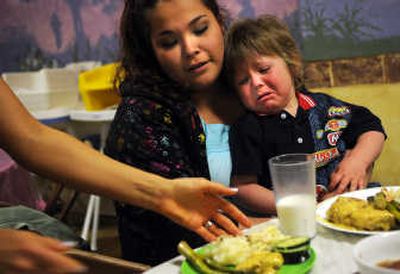Rising food costs squeeze consumers, agencies

Laura Bowman has seen the food bill at her North Side day-care center rise several hundred dollars a month.
Michelle Swanson has stopped eating meat and switched to soy milk. Dan Grady says he can’t afford the food he wants – local, organic products. And at the Women’s and Children’s Free Restaurant, organizers spent 57 percent more on food this January and February than last – a result of increased prices and increased need among low-income families. Some foods, such as eggs, are no longer offered.
“It’s affecting our budget, but more than that it’s affecting our families,” said Marlene Alford, executive director of the program.
The increase in food prices over the past year or so isn’t new to most people who pay attention to their grocery bills. But analysts say food inflation – now at a 17-year high – is expected to keep rising, outpacing overall inflation and placing the world’s poorest people in dire circumstances.
U.S. food prices rose 4 percent, on average, in 2007, though many staples such as eggs, dairy products and chicken have increased by much more. That compares with an average 2.5 percent annual rise for the past 15 years, according to the U.S. Department of Agriculture. And the agency says 2008 could be worse, with an average rise of as much as 4.5 percent.
Rice prices have jumped drastically as well, and higher wheat prices – a boon for Palouse farmers – have rippled through the economy.
Higher food and energy prices are expected to push the government’s Consumer Price Index higher for March. Analysts are forecasting that today’s Department of Labor report will show the index rose at a 4 percent annual rate in the first three months of the year, up from last year’s overall rise of 2.8 percent.
Doug Wordell, the director of nutrition services for Spokane Public Schools, said he’s seen the price of fresh produce nearly double in the past year or so. The higher prices and a week of snow days have combined to put the district’s meals programs a couple hundred thousand dollars short of projections.
“It hits everybody,” he said. “Nobody is immune, from restaurants to the mom and dad at home trying to buy fresh fruits and vegetables.”
Worldwide, the explosion in food prices dwarfs the U.S. increases. The United Nations food index has risen 57 percent in the past year, and many commodities such as rice, soybeans and corn have more than doubled.
Global aid organizers say starvation threatens millions in the poorest countries and that if prices stay high – as analysts predict they will – hunger could undermine political stability in countries dependent on imports. Already, food-related riots and strikes have occurred in Haiti and Egypt.
The reasons offered for the inflation are familiar – high fuel prices, rising demand for products in global markets, competition for commodities from biofuels, among others.
In the United States, the problems are less severe, though the price increases seem shocking after years of low food inflation. American households spend a smaller chunk of their budget on food than households in any other country – 7.2 percent in 2006, according to the USDA. By contrast, the figure was 22 percent in Poland and more than 40 percent in Egypt and Vietnam.
Still, when food prices rise, many people have to give up something else.
For Dan Grady, 40, that’s been restaurant meals and a gym membership. Grady, who lives in Spokane with his wife and works in sales for a Japanese semiconductor company, said he first noticed the rising prices in produce. Now, he said, “it’s across the board, and it’s disconcerting. As the food bill goes up, we have to cut elsewhere.”
Grady wants to buy more local, organic food but finds it too expensive. Michelle Swanson said such foods can be more expensive depending on where you buy them, but that some organic food options are less expensive.
She participates in Fresh Abundance, an organic store with a delivery service, and said she’s saved money on her produce bill. She also said she’s stopped drinking cow milk in favor of soy milk. She’d like to buy as much food as she can from local producers to help limit the impact of energy use.
“If you cut out the oil being burned to buy your food, your price is much better,” she said.
Laura Bowman owns Care-A-Lot Learning Center on West Wellesley Avenue. While her food bill has grown from between $3,000 and $3,500 a month to nearly $4,000, she’s also seen other effects of higher prices.
From the viewpoint of a struggling family, “instead of paying your day-care bill you’re going to feed your family,” she said.
Restaurants and bakeries are being hit by the price increases as well. Sue Teague, who owns Cielo Bakery, has seen most basic ingredients get more expensive.
“Flour has doubled and tripled, depending on where you buy it,” she said. “I think flour’s taking the biggest jump overall of any of the basic products. Sugar has gone up. Eggs have gone up. Ninety-five percent of dairy has gone up.”
Alford said the number of people seeking help at the Women’s and Children’s Free Restaurant is growing. On a recent “takeout” day, the organization provided groceries for 154 women and 184 children, she said.
The nonprofit serves free dinners twice a week and offers fresh produce, groceries and other staples one day a week, with an emphasis on fresh and healthy food.
Alford noted that over recent decades, the price of processed foods has risen less dramatically than that of produce, dairy products and other fresh food – making it cheaper for struggling families to eat less-nutritious meals.
The restaurant has been providing meals since 1988. It expanded four years ago to add one weekly lunch and the free takeout day.
“We never have seen our prices increase to this degree,” Alford said.